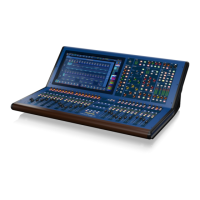108 HD96-24-CC-TP User Manual
Solo Hierarchy
Solo signals are divided into ve layers: Input Solo, Aux Return Solo, Aux & Flexi Aux Bus Solo, Matrix Bus Solo and Master Buss Solo. The illustration below shows the
priority of the Solo function. After you have switched layers from the lower to upper levels by cancelling a solo for the upper layer, the previous Solo status of the layer
immediately below will be restored. For example, if you switch layers in the order of:
Input Solo →Aux Return Solo → Flexi Aux & Aux Bus Solo → Matrix Bus Solo → Master Bus Solo, you can then successively cancel the Solo button to successively
restore the Solo status of the previously selected layer.
The solo system add-mode hierarchy works as follows:
The highest level of solos will be the inputs and returns. When active, these will override and inhibit the remaining solo sources (exi auxes, auxes,
matrices and masters).
Within the constraints of the two-level solo hierarchy, only one source can be active on any channel at any instant:
• • Input channels: Input channel <--> Aux AFL <--> Direct out
• • Aux Return channels: Return channel
• • Aux busses: Aux bus <--> Direct in <-->
• • Matrix outputs: Matrix bus <--> Direct in <-->
• • Master outputs: Master bus <--> Direct in <--> Side chain listen
An additional constraint is placed on the side chain listen. This is due to the nature of the DSP, where only one side chain listen can be auditioned at any one time,
regardless of whatever else is active in the same solo hierarchy level.
If an input channel solo is active via a VCA master solo, soloing the input temporarily overrides the VCA master solo. However, soloing a direct input or AFL solo on the
same channel or a side chain solo on any channel, cancels both the input solo on that channel.
VCA Solo
If input and outputs are assigned to the same VCA it is possible to solo it and hear all the contributions together. If a path is soloed within a VCA, when that path is
un-soloed the VCA solo will return. If Solo add mode is engaged only inputs will be sent to the solo bus. If two channels are in a VCA together and the rst is set to
Monitor A bus while the second is set to Monitor B bus. The two channels will still be soloed in the Monitor busses they are assigned to and not merged to the same
Monitor bus.
Solo In Place (SIP)
In the Midas analogue console days, the yellow solo in place button (SIP) would be found with a protective cover over it. It was also known as the ‘P45 button’ (P45
is a UK form given after being red) because if SIP was accidently used in a show, everything apart from the soloed instrument would disappear along with your
mixing career!
Saying that, SIP can be a very useful tool in sound check to solo an instrument or voice while cutting all channels from the main mix (except soloed ones) by pressing a
solo button. SIP lets you check the contribution from soloed channels at the actual levels they occur in the mix, that is, considering the main fader setting.
To prevent accidental SIP activation, the SIP button has a long button press to save it accidentally being turned on.
For SIP purposes, master outputs can be the main master bus.

